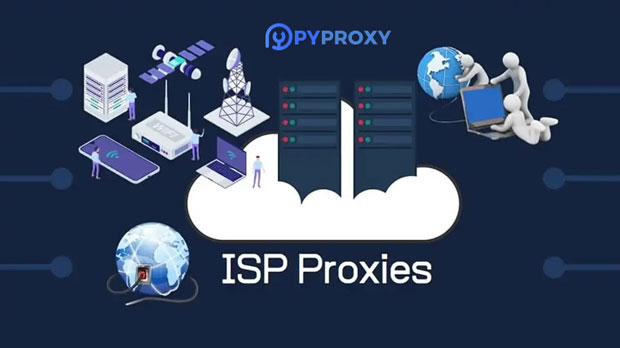When it comes to selecting proxies for enterprise-level IPv6 requirements, the decision often narrows down to two popular options: PYPROXY and PlainProxies. Each offers distinct advantages, but which one is more suitable for large-scale, IPv6-specific applications? This article explores the core features of both, compares their performance, and delves into which option best meets the demands of enterprise-grade IPv6 proxy usage. Introduction to PyProxy and PlainProxiesIn the growing digital landscape, enterprises increasingly rely on proxies for security, anonymity, data scraping, and bypassing geo-restrictions. Among the most prominent proxy providers are PyProxy and PlainProxies, each offering services aimed at fulfilling business and technical needs. PyProxy is widely recognized for its ability to work seamlessly with dynamic and rotating proxies, particularly for those needing enhanced anonymity or security, especially in the context of IPv6 adoption. PlainProxies, on the other hand, tends to focus more on simplicity and stability, catering to users who need reliable, straightforward proxy solutions without additional complexities. When enterprises look for IPv6 proxy solutions, it is crucial to assess several factors, including ease of integration, scalability, reliability, and performance. While both PyProxy and PlainProxies provide IPv6 proxy services, understanding their individual strengths and weaknesses is essential for making an informed decision.Understanding the Needs of Enterprise-Level IPv6 Proxy UsersBefore comparing PyProxy and PlainProxies, it is important to understand the unique requirements of enterprise-level IPv6 proxy users. 1. Scalability: Large businesses often require a proxy solution that can scale to handle a high volume of requests simultaneously. IPv6, with its vastly larger address space, poses unique challenges in terms of managing proxy connections. 2. Security: Enterprises need robust security measures to prevent data breaches and cyber-attacks. Proxies must not only mask IP addresses but also ensure that traffic is encrypted and secure.3. Performance: Performance is a key factor when dealing with proxies. Latency, speed, and reliability can significantly impact the success of web scraping, digital marketing, or any other proxy-based operations.4. Compatibility: Since IPv6 is becoming more common, enterprises must ensure that their proxy solution is compatible with IPv6 infrastructure, which often requires specialized tools and configurations.In-Depth Analysis of PyProxyPyProxy has gained popularity because of its robust, flexible, and scalable architecture. Here are some key features that make PyProxy stand out for IPv6 proxy solutions:1. Dynamic and Rotating Proxies: One of PyProxy's core strengths is its dynamic proxy rotation system, which changes the IP address regularly to avoid detection. For enterprises using IPv6, this is particularly beneficial since large IP address spaces allow for extensive rotations without repeating IP addresses, ensuring anonymity and security.2. Automation and Customization: PyProxy supports automation, which allows enterprises to easily manage and configure large pools of proxies. This is especially helpful when businesses are dealing with vast amounts of data and need automated processes for scraping or accessing geo-restricted content.3. Security Features: PyProxy places a strong emphasis on security, providing features like encryption and data protection. For enterprises handling sensitive information, these added security layers are invaluable in mitigating potential data breaches.4. IPv6-Specific Optimization: PyProxy is specifically designed to support IPv6 addresses, ensuring that businesses using IPv6 infrastructure can integrate and utilize proxies without compatibility issues. It’s optimized to take full advantage of IPv6’s vast address pool, which is crucial for businesses needing to scale their operations across various networks.5. High Availability and Reliability: PyProxy offers features that ensure its proxies are always available and operational, even during high-demand periods. This is a critical requirement for enterprises with time-sensitive or high-volume needs.In-Depth Analysis of PlainProxiesPlainProxies, while simpler in design, offers a different set of strengths that may appeal to businesses with specific proxy requirements. Here's a closer look at what PlainProxies brings to the table:1. Simplicity and Stability: PlainProxies is built for users who prioritize stability over complex features. For enterprises that don’t need frequent IP rotations or advanced customization, PlainProxies offers a straightforward solution for reliable, continuous proxy usage.2. IPv6 Support: Like PyProxy, PlainProxies supports IPv6 proxies, allowing enterprises to tap into the full potential of IPv6 address spaces. However, its approach to IPv6 may not be as dynamic as PyProxy’s, which could limit its scalability in certain scenarios.3. Cost-Effectiveness: PlainProxies tends to be more affordable, which might make it an attractive option for businesses looking to minimize overhead costs while still benefiting from IPv6 proxy capabilities.4. Ease of Use: PlainProxies is known for being easy to integrate into existing infrastructures. For enterprises with limited technical resources, PlainProxies offers an accessible option without requiring complex configurations or management.5. Performance: While reliable, PlainProxies may not match PyProxy's performance in high-demand, high-traffic scenarios. Its lack of automation and rotation systems means it may be more suitable for businesses that need a consistent and stable proxy but do not require frequent changes or scalability.Comparing PyProxy and PlainProxies for Enterprise IPv6 NeedsNow that we've broken down the core features of both PyProxy and PlainProxies, it’s time to compare them in the context of enterprise-level IPv6 proxy usage.1. Scalability: PyProxy is the clear winner here, thanks to its dynamic proxy rotation and ability to handle high traffic volumes without sacrificing performance. For businesses needing to scale rapidly or manage large datasets, PyProxy is the better choice.2. Security: Both services offer basic security features, but PyProxy provides additional layers, such as encryption, which are crucial for enterprises handling sensitive data. Therefore, PyProxy’s security features make it more suitable for enterprises with higher security demands.3. Ease of Use: While PyProxy offers extensive features and customization, it may require more technical expertise to set up and manage. PlainProxies, on the other hand, is simpler to integrate, making it an attractive option for businesses with limited technical resources.4. Performance: In terms of performance, PyProxy is more suited for high-demand use cases, such as web scraping or content delivery, where proxy rotations and high availability are key. PlainProxies may struggle in such high-traffic environments, making it more suitable for smaller-scale operations.5. Cost: PlainProxies tends to be more cost-effective, which could appeal to smaller businesses or enterprises with budget constraints. However, PyProxy offers a more feature-rich experience that justifies the higher cost for those requiring advanced proxy functionality.Conclusion: Which is More Suitable for Enterprise-Level IPv6 Proxy Needs?When considering PyProxy and PlainProxies for enterprise-level IPv6 proxy requirements, PyProxy emerges as the better choice for most large-scale, security-conscious, and high-performance use cases. Its ability to scale dynamically, prioritize security, and optimize for IPv6 makes it ideal for businesses with complex needs.However, PlainProxies offers a simpler, more cost-effective alternative for businesses that prioritize ease of use and stability over advanced functionality. While it may not meet the demands of every enterprise, it is a solid solution for businesses with basic proxy needs.Ultimately, the decision between PyProxy and PlainProxies should be based on the enterprise’s specific requirements, including scalability, security, performance, and budget considerations. By understanding the unique strengths of each provider, businesses can make an informed choice that aligns with their IPv6 proxy needs.
Mar 31, 2025
![arrow]()



























































